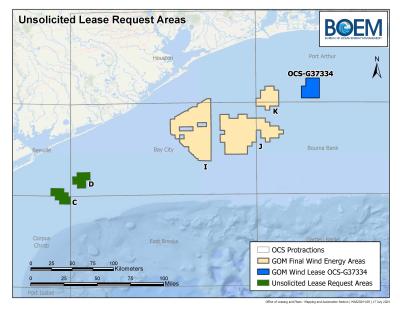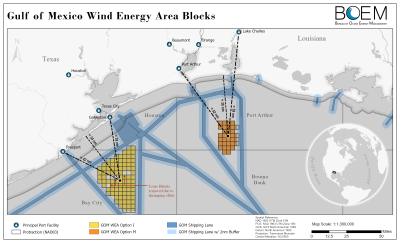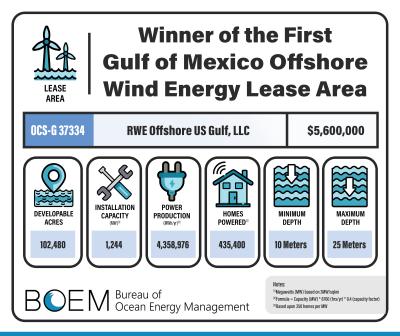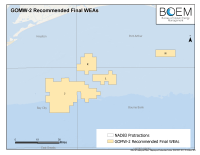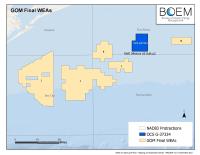What's New?
On Dec. 12, 2024, BOEM announced that it is issuing a Determination of Competitive Interest in two Wind Energy Areas (WEAs) in the Gulf of America. The determination is in response to an unsolicited request received by Hecate Energy Gulf Wind LLC expressing interest in acquiring a commercial wind energy lease for WEA options C and D.
Upon receiving Hecate Energy Gulf Wind LLC’s request, BOEM published a Request for Competitive Interest (RFCI) on July 29, 2024. In response, Invenergy GOM Offshore Wind LLC also expressed interest in WEA options C and D, and BOEM has deemed both Hecate and Invenergy to be legally, technically, and financially qualified to hold an OCS renewable energy lease in the Gulf of America. As a result of this review, BOEM has determined that competitive interest exists in the RFCI areas.
- Federal Register Notice
- Competitive Interest Memo
- Hecate Energy Gulf Wind LLC Unsolicited Application for an Outer Continental Shelf Renewable Energy Lease
- Invenergy GOM Offshore Wind LLC RFCI Response
Background
On Feb. 16, 2024, BOEM received an unsolicited application from Hecate Energy for commercial wind energy lease(s) on the Gulf of America Outer Continental Shelf in WEA options C and D. The areas are located off the coast of Southeast Texas. The first, WEA option C, totals 74,113 acres, and the second, WEA option D, totals 68,239 acres. The entire area comprises approximately 142,352 acres.
Hecate Energy’s proposed Gulf Wind Offshore Wind Project 2 aims to generate up to 2 gigawatts of renewable energy in the Gulf. Hecate Energy proposes multiple potential uses for this renewable energy, including interconnection to the electric grid, sale in power purchase agreements to private off-takers, or use for Wind-to-X technologies through which offshore wind energy is used to produce another energy resource. The proposed project would consist of up to 133 fixed-bottom wind turbine generators, each with a capacity of 15-23 megawatts (MW). This would result in an overall maximum capacity of approximately 3,000 MW.
On July 29, 2024, BOEM published a RFCI for Gulf WEA options C and D in the Federal Register for a 45-day public comment period.
BOEM received 18 comments during the RFCI comment period, including one expression of interest from Invenergy. Many of the RFCI comments addressed concerns about the suitability of the RFCI Areas for leasing. To the extent they are relevant, BOEM will take all the comments it received during the RFCI comment period into consideration in potential future leasing steps.
Comment submissions can be viewed by visiting the Federal eRulemaking Portal: https://www.regulations.gov/. In the search box at the top of the webpage, enter BOEM-2024-0039, and click "search."
BOEM issued this RFCI because regulations require that BOEM identify whether or not there is competitive commercial interest in any area that is the subject of an unsolicited lease request.
Projects Underway
Public Engagement
- Gulf of Mexico Intergovernmental Renewable Energy Task Force Meetings
- Fisheries Engagement Meeting (4/30/2024)
- eNGO Engagement Meeting (4/30/2024)
- Gulf Wind Two Auction Seminar
- Offshore Operations Committee Meeting Presentation (06/27/2024)
- BOEM Offshore Wind Round Table Agenda (08/02/2023)
- Wind Roundtable Meeting (08/02/2023)
- Gulf of Mexico Draft EA Meeting (08/09/2022)
- Gulf of Mexico Fisheries Summit (01/19/2022)
Announcements
- BOEM Announces Next Steps in Competitive Leasing Process for Offshore Wind Energy in Gulf of Mexico (12/12/2024)
- BOEM Announces Next Steps for Offshore Wind in Gulf of Mexico (07/26/2024)
- Interior Department Proposes Second Offshore Wind Sale in Gulf of Mexico (03/20/2024)
- Biden-Harris Administration Holds First-Ever Gulf of Mexico Offshore Wind Energy Auction (08/29/2023)
- Biden-Harris Administration Announces First Ever Offshore Wind Lease Sale in the Gulf of Mexico (07/20/2023)
- BOEM Completes Environmental Review of Offshore Wind Leasing in the Gulf of Mexico (05/30/2023)
- You’re Invited: Gulf of Mexico Intergovernmental Renewable Energy Task Force Meeting (03/21/2023)
- Interior Department Proposes First-Ever Offshore Wind Sale in Gulf of Mexico (02/22/2023)
- BOEM Designates Two Wind Energy Areas in Gulf of Mexico (10/31/2022)
- BOEM Extends Public Comment Period for Potential Gulf of Mexico Wind Energy Areas and Draft Environmental Assessment (08/10/2022)
- Department of the Interior announced it is seeking public comments on two draft Wind Energy Areas (WEAs) in the Gulf of Mexico (07/20/22)
- BOEM Initiates Environmental Assessment for Offshore Wind in the Gulf of Mexico (01/11/22)
- Interior Department Takes Action to Advance Offshore Wind in the Atlantic and Gulf of Mexico (10/28/21)
- Interior Department to Explore Offshore Wind Potential in the Gulf of Mexico (06/08/21)
Request for Interest (RFI)
BOEM published a Request for Interest (RFI) in the Federal Register on June 11, 2021, to assess interest in potential offshore wind development in the OCS. The RFI focused on the Western and Central Planning Areas of the Gulf of Mexico offshore the states of Louisiana, Texas, Mississippi, and Alabama.
The RFI comment period closed on July 26, 2021, and 39 comments were received in response. BOEM determined that competitive interest exists for an area identified by the RFI.
Call for Information and Nominations (Call)
On Nov. 1, 2021, BOEM published a Call for Information and Nominations (Call) to further assess commercial interest in, and invite public comment on, possible commercial wind energy leasing in a proposed area within the RFI area.
The Call Area consisted of almost 30 million acres just west of the Mississippi River to the Texas/Mexican border.
- Call - Federal Register Notice
- Call - Map
Final Wind Energy Areas
On October 31, 2022, BOEM announced it has finalized two Wind Energy Areas (WEAs) in the Gulf of Mexico. The first final WEA is located approximately 24 nautical miles (nm) off the coast of Galveston, TX. The area totals 508,265 acres and has the potential to power 2.1 million homes with clean wind energy. The second final WEA is located approximately 56 nm off the coast of Lake Charles, LA. The area totals 174,275 acres and has the potential to power over 740,000 homes. The next steps in BOEM’s renewable energy competitive leasing process include issuing a Proposed Sale Notice for a 60-day public comment period later this year or early next.
- Final Signed Area ID Memo
- WEA Modeling Report (BOEM and NCCOS are working on an addendum to the A WIND ENERGY AREA SITING ANALYSIS FOR THE GULF OF MEXICO CALL AREA found on our website that will correct the term "carbon capture lease blocks" to "potential carbon capture areas" on Figure 3.8 and text throughout the report. This was an oversight by BOEM.)
- WEA options for GOAW
Environmental Review
On Jan. 11, 2022, BOEM announced that it prepared a draft environmental assessment (EA) considering potential offshore wind leasing in federal waters of the Gulf of Mexico. The draft EA considered potential environmental consequences of site characterization activities (i.e., biological, archaeological and geological, as well as geophysical surveys and core samples) and site assessment activities (i.e., installation of meteorological buoys) associated with the possibility of issuing wind energy leases in the Western and Central Gulf of Mexico. More information was found on the Gulf of Mexico Draft EA.
On July 20, 2022, the Department of the Interior announced it was seeking public comments on two draft Wind Energy Areas (WEAs) in the Gulf of Mexico. The first draft WEA was located approximately 24 nautical miles (nm) off the coast of Galveston, TX, covering a total of 546,645 acres, with the potential to power 2.3 million homes with clean wind energy. The second draft WEA was located approximately 56 nm off the coast of Lake Charles, LA, covering a total of 188,023 acres, with the potential to power 799,000 homes. Public comments on the draft WEAs were accepted for 30 days beginning July 20, 2022. More information can be found on the Gulf of Mexico Draft WEAs.
On May 25, 2023, BOEM announced the final environmental assessment (EA). BOEM's environmental analysis found no significant impacts.
Proposed Notice of Sale
On Feb. 24, 2023, BOEM issued a Proposed Sale Notice in the Federal Register for a 60-day public comment period. The Proposed Sale Notice (PSN) included a 102,480-acre area offshore Lake Charles, Louisiana, and two areas offshore Galveston, Texas, one comprising 102,480 acres and the other comprising 96,786 acres.
The PSN published in the Federal Register on February 24, 2023, opening a 60-day public comment period ending at 11:59 pm ET on April 25, 2023. To comment on the proposed revisions, go to www.regulations.gov and search for docket number BOEM-2023-0021.
Auction Seminar
BOEM held an offshore wind auction seminar on March 23, 2023, for prospective bidders, which was open to the public. The seminar described the auction format, explained the auction rules and demonstrated the auction process through meaningful examples.
- Agenda
- Video
- Proposed Sale Notice (PSN)
- Proposed Lease OCS-G 37334
- Proposed Lease OCS-G 37335
- Proposed Lease OCS-G 37336
- Bidder's Financial Form
- Bidder's Financial Form Addendum
- Proposed Wind Energy Lease Areas (ZIP)
- Payment Instruction
- Qualification Guidelines
Final Notice of Sale
Final WEAs NAD83 Pts Area M
Final WEAs I & M Blocks
WEA I & M Shape Files with Metadata
The Final Sale Notice (FSN) published in the Federal Register on July 21, 2023. The FSN provided detailed information about the final lease areas, lease provisions and conditions and auction details. It also identified qualified companies who could participate in the lease auction.
- Final Sale Notice (FSN)
- Lease OCS G – 37334
- Lease OCS G – 37335
- Lease OCS G – 37336
- Gulf of Mexico Final Sale Notice Decision Memorandum
- Gulf of Mexico Final Sale Notice Response to Comments
- Bidder's Financial Form
- Bidder's Financial Form Addendum
- Auction System Technical Supplement
- BOEM Form 2032 - Equal Opportunity Affirmative Action Program Representation
- BOEM Form 2033 - Equal Opportunity Compliance Report Certification
- Final environmental assessment (EA)
- Finding of No Significant Impact (FONSI)
Maps
- Lease Sale Area OCS G – 37334
- Lease Sale Area OCS G – 37335
- Lease Sale Area OCS G – 37336
- Shape file for Gulf of Mexico Lease Sale Area
Gulf of Mexico Wind Auction 1
On August 29, 2023, BOEM held the first-ever offshore wind energy auction for the Gulf of Mexico region, resulting in one lease area receiving a high bid of $5.6 million. RWE Offshore US Gulf, LLC was the winner of the Lake Charles Lease Area, which has the potential to generate approximately 1.24 gigawatts of offshore wind energy capacity and power nearly 435,400 homes with clean, renewable energy.
Winners and high bids for each of the lease areas and a Round-by-Round Summary are identified below.
As required by the lease, RWE is required to develop three publicly available communication plans. Additional information is provided below.
- The Native American Tribes Communication Plan will describe the strategies that the Lessee intends to use for communicating with federally recognized Tribes and outlines methods for engaging with and disseminating information to federally recognized Tribes with cultural and/or historical ties to the lease area. This plan will be ready by August 31, 2024.
- The Fisheries Communication Plan will describe the strategies that the Lessee intends to use for communicating with commercial and recreational fisheries prior to and during activities in support of the submission of a plan, such as a Site Assessment Plan or Construction and Operations Plan. The plan will include information on the distribution of “Notice to Mariners” and other outreach and coordination. Additionally, the plan will include RWE’s Fisheries Liaison as a primary point of contact and a process to file complaints with RWE and seek replacement of or compensation for lost gear. This plan will be ready by May 31, 2024.
- The Agency Communication Plan will describe the strategies that the Lessee intends to use for communicating with federal, state, and local agencies with authority related to the lease area. The plan will outline specific methods for engaging with and disseminating information related to permits and trust resources to these agencies. This plan will be ready by May 31, 2024.
Final Wind Energy Areas - Gulf of Mexico Wind Auction Two
On October 27, 2023, BOEM announced it has finalized four Wind Energy Areas (WEAs) in the Gulf of Mexico. (See figure 1) Together, the WEAs have the potential to produce enough clean, renewable energy to power more than three million homes. The first WEA (Option J) is located approximately 47.2 miles off the coast of Texas. The area totals 495,567 acres and has the potential to power 2.1 million homes. The second area (Option K) is located approximately 61.5 miles off the coast of Texas. The area totals 119,635 acres and has the potential to power 508,200 homes. The third WEA (Option L) is located approximately 52.9 miles off the coast of Texas. The area totals 91,157 acres and has the potential to power 387,450 homes. The fourth WEA (Option N) is located approximately 82 miles off the coast of Louisiana and totals 56,978 acres. Option N has the potential to power approximately 242,000 homes.
The above final WEAs join WEA I, which was designated a final WEA on October 31, 2022. (See figure 2)
Supporting Documents
- Memorandum for GOMW-2 Area ID
- GOM Final Wea's
- PSN Federal Register
- GOM Proposed Lease GOMW-2 OCS-G 37962 and associated map
- GOM Proposed Lease GOMW-2 OCS-G 37963 and associated map
- GOM Proposed Lease GOMW-2 OCS-G 37964 and associated map
- GOM Proposed Lease GOMW-2 OCS-G 37965 and associated map
- Bidder's Financial Form
- Bidder's Financial Form Addendum
- GOM Proposed Wind Energy Lease Areas (ZIP)


